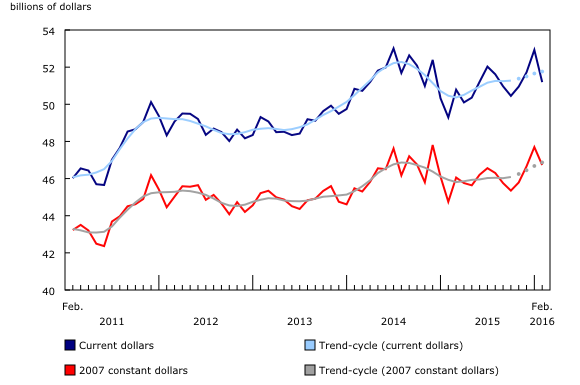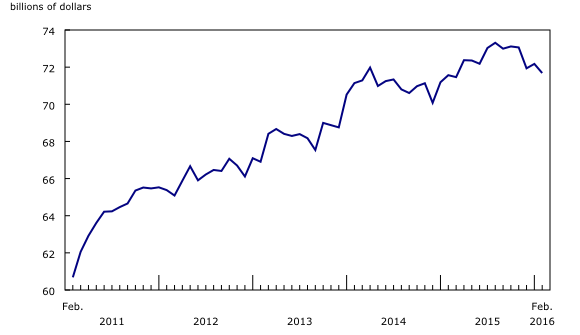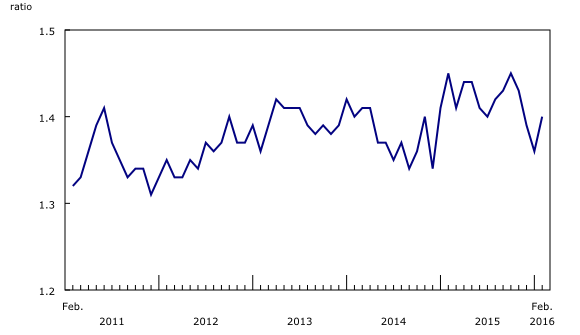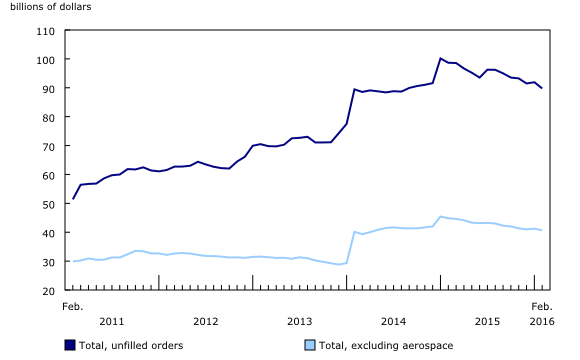Monthly Survey of Manufacturing, February 2016
Archived Content
Information identified as archived is provided for reference, research or recordkeeping purposes. It is not subject to the Government of Canada Web Standards and has not been altered or updated since it was archived. Please "contact us" to request a format other than those available.
Released: 2016-04-15
Manufacturing sales decreased 3.3% to $51.2 billion in February, following three months of consecutive gains.
Sales were down in 16 of 21 industries, representing 73.5% of the manufacturing sector. Motor vehicles and petroleum and coal products were responsible for over two-thirds of the decrease. Motor vehicle parts, aerospace product and parts, and machinery also contributed to the decline.
In constant dollars, sales declined 2.0%, reflecting a lower volume of goods sold.
Motor vehicles and petroleum and coal post largest decreases
Sales of motor vehicles fell 10.5% in February, following four consecutive gains. In February, motor vehicle manufacturers typically continue to ramp up from their December shutdowns. This year, the gain in unadjusted sales was smaller than usual, which led to the drop, after seasonal adjustment was applied. Despite the seasonally adjusted decrease, unadjusted sales for the industry are at the highest level since March 2007. The industry has experienced sustained growth over the last year as manufacturers shifted production towards higher-end or more expensive vehicles.
Sales of petroleum and coal products fell 12.6% in February, a ninth consecutive decrease. Prices declined for the eighth consecutive month, down 4.3% on a monthly basis according to the Industrial Product Price Index. Over the last year, the industry's weaker performance has reflected lower prices. Operating profits for petroleum and coal products fell 30.6% in the fourth quarter, the second consecutive quarterly decline according to the Quarterly Financial Statistics for Enterprises.
The motor vehicle parts industry declined 2.9%, following five consecutive increases. Most motor vehicle assembly plants order parts on a just-in-time basis, often keeping less than a day of inventory on hand, so the performance of the parts industry tends to follow that of motor vehicles.
Production in aerospace product and parts fell 4.0%, a second consecutive decline.
Lower sales of machinery also contributed to the overall decrease. Sales fell 2.7% for the industry and are at the lowest level since April 2011. Machinery manufacturers tied to the oil and gas extraction sector have reported lower demand over the last year and some establishments have closed.
Sales down in seven provinces
Sales declined in seven provinces in February, with Ontario, Quebec and New Brunswick posting the largest decreases.
Sales in Ontario were down 3.2% to $25.6 billion, following four consecutive monthly gains. The decline in February reflected a 10.5% drop in motor vehicle sales and a 2.9% decrease in sales of motor vehicle parts.
After three months of increases, sales in Quebec fell 4.1%. The decrease was mostly caused by a drop in petroleum and coal products and a 10.1% decline in the aerospace product and parts industry. Sales were also down in fabricated metal products (-5.7%).
In New Brunswick, sales fell 17.2% to $1.2 billion, mainly as a result of a 21.9% drop in non-durable goods sales. Exports of refined petroleum product also declined. Manufacturing sales in the province have generally been on a downward trend since May 2015, when they were $1.6 billion. Since then, sales have declined 23.7%.
Inventories fall
Inventories fell 0.7% in February, reaching the lowest level since March 2015. Inventories decreased in 10 of 21 industries. Lower inventories for petroleum and coal product, computer and electronic product, and aerospace product and parts accounted for the majority of the decline. The decrease in aerospace reflects a stronger Canadian dollar relative to the US dollar. Inventories are mainly held in US dollars for the aerospace industry, so currency fluctuations will influence trends.
The inventory-to-sales ratio increased from 1.36 in January to 1.40 in February. This ratio measures the time, in months, that would be required to exhaust inventories if sales were to remain at their current level.
Unfilled orders decline
Unfilled orders declined 2.3% in February, as manufacturers in 13 of 21 industries reported decreases. A 3.1% decline in unfilled orders of aerospace product and parts accounted for most of the drop in February.
New orders were down 8.1%, the largest decline since February 2015. There were fewer new orders in the aerospace, motor vehicle, and petroleum and coal product industries.
Note to readers
Monthly data in this release are seasonally adjusted and are expressed in current dollars unless otherwise specified. For more information on seasonal adjustment, please refer to Seasonally adjusted data – Frequently asked questions
For more information on the trend-cycle data, see Trend-cycle estimates – Frequently asked questions.
Non-durable goods industries include food, beverage and tobacco products, textile mills, textile product mills, clothing, leather and allied products, paper, printing and related support activities, petroleum and coal products, chemicals, and plastics and rubber products.
Durable goods industries include wood products, non-metallic mineral products, primary metal, fabricated metal products, machinery, computer and electronic products, electrical equipment, appliances and components, transportation equipment, furniture and related products, and miscellaneous manufacturing.
Production-based industries
For the aerospace industry and shipbuilding industries, the value of production is used instead of sales of goods manufactured. This value is calculated by adjusting monthly sales of goods manufactured by the monthly change in inventories of goods in process and finished products manufactured. Production is used due to the extended period of time that it normally takes to manufacture products in those industries.
Unfilled orders are a stock of orders that will contribute to future sales assuming that the orders are not cancelled.
New orders are those received whether sold in the current month or not. New orders are measured as the sum of sales for the current month plus the change in unfilled orders from the previous month to the current month.
Manufacturers reporting in US dollars
Some Canadian manufacturers report sales, inventories and unfilled orders in US dollars. These data are then converted to Canadian dollars as part of the data production cycle.
For sales, based on the assumption that they occur throughout the month, the average monthly exchange rate for the reference month (noon spot rate) established by the Bank of Canada is used for the conversion. The monthly average exchange rate is available in CANSIM Table 176-0064.
Inventories and unfilled orders are reported at the end of the reference period. For most respondents, the noon spot exchange rate on the last working day of the month is used for the conversion of these variables. However, some manufacturers choose to report their data as of a day other than the last day of the month. In these instances, the noon spot exchange rate on the day selected by the respondent is used. Note that because of exchange rate fluctuations, the noon spot exchange rate on the day selected by the respondent can differ from both the exchange rate on last working day of the month and the monthly average exchange rate. Noon spot exchange rate data are available in CANSIM Table 176-0067.
Revision Policy
Each month, the Monthly Survey of Manufacturing releases preliminary estimates for the reference month and revised estimates for the three previous months. Revisions are made to reflect new information provided by respondents and updates to administrative data. Once per year, a revision project is undertaken where multiple years of data are revised. During annual revisions, changes are made to our seasonal adjustment parameters.
Real-time CANSIM tables
Real-time CANSIM tables 304-8014, 304-8015 and 377-8009 will be updated on April 29. For more information, consult the document Real-time CANSIM tables.
Next release
Data from the March Monthly Survey of Manufacturing will be released on May 17.
Contact information
For more information, contact us (toll-free 1-800-263-1136; 514-283-8300; STATCAN.infostats-infostats.STATCAN@canada.ca).
To enquire about the concepts, methods or data quality of this release, contact Elizabeth Richards (613-863-4623; elizabeth.richards@canada.ca) or Michael Schimpf (613-863-4480; michael.schimpf@canada.ca), Manufacturing and Wholesale Trade Division.
- Date modified:







